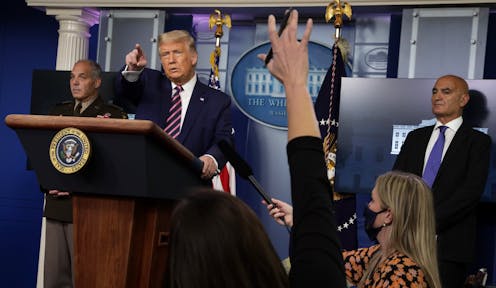After prolonged period of press-bashing, a more constructive form of media criticism is now flourish
Press-bashing was a feature of the years Trump was president. But a new, more constructive kind of press criticism has also emerged that aims to improve journalism, not delegitimize it.

Over the past several years, and maybe even longer, it seems as if every day brings a new round of attacks on the American press.
Some of these attacks come under the guise of criticism: accusations of being “fake news”; arguments that journalists are biased. But some more seriously threaten journalists themselves. Just recently, Fox News host Tucker Carlson unleashed what was described as a “calculated and cruel” verbal assault against New York Times reporter Taylor Lorenz repeatedly on his show. Some rallies for Donald Trump even saw attendees displaying threats of lynching reporters on a T-shirt.
This kind of criticism – attempting to delegitimize the press – serves to undermine trust in the work that journalists do. But even if these attacks on the press seem prominent now, they are part of a decadeslong trend.
The public’s trust in the media began declining in the mid-1970s. By 2020, a Pew Research Center survey found that more than half of the American public had either “not too much” confidence in the news media or none at all.
That erosion reflected a growing distrust of institutions and a trend toward political partisanship that sent readers toward news outlets that reflected their own points of view. The rise of conservative critics of the mainstream press also contributed to this erosion of media trust.
Over the past five years, though, another kind of press criticism has come to prominence after a period of marginalization. This brand of press criticism takes a free and independent press as a necessity for life in a democratic society.
Instead of seeking to delegitimize the press, these critics are simultaneously explaining the workings of the press to the public and holding it accountable in its role as the public’s representative and watchdog.

Explaining and holding accountable
In recent weeks, these critics have pointed out that many reporters were hasty in passing along a Georgia sheriff’s statement that the alleged murderer of eight people was having “a bad day.” And they have also tried to explain why members of the press care so much about whether or not President Joe Biden holds a press conference, despite the fact that the public, largely, is unconcerned.
I am a scholar of press criticism. My research has shown that good faith press criticism can actually strengthen the press and the public’s trust in it.
Much of my research is based on the work of the press scholar James Carey, who in 1974 wrote an essay that called for a culture of press criticism to take root in the U.S. He observed that far more effort went into criticizing film and fiction and poetry than criticizing journalism – and yet most people consume much more news than poetry.
Carey believed that critics who understand the processes of the press could help the news-consuming public understand better what they were reading or watching. At the same time, the critics and the public would hold the press to a higher standard.
Good and bad faith
The social upheaval of the second half of the 1960s led many reporters during the 1970s to conclude that the bland, detached tone that was required by news organizations’ so-called objectivity could not accurately portray the divisions in society.
J. Anthony Lukas, a Pulitzer Prize–winning New York Times reporter, wrote a book about how the paper would not let him cover the Chicago 7 conspiracy trial as the political show trial he saw it to be. They insisted that he describe it “objectively,” using the same characterization of the trial that the prosecutors used, without regard for the perspectives of the defendants or Lukas’ own judgment.
Younger reporters such as Lukas began to realize that the so-called objective news values and practices that their editors insisted on actually biased the press toward preserving the status quo, and people who were already in power.
As the 1970s began, two major reporting events – the publication of the Pentagon Papers in 1971 and The Washington Post’s Watergate reporting – convinced many reporters that the government was not always working for the public good. These works of journalism exposed government and politicians acting against the public interest, and even illegally.
In response, several regional journalism reviews cropped up. This movement culminated in the launch of a magazine called (MORE), which was based in New York City but aspired to a national audience.
In my book about (MORE), I argue it is the publication that has come closest to achieving James Carey’s goal of press criticism addressed to nonspecialist readers.
In the 1970s, (MORE) and other critics pushed publications to hire more women and nonwhite reporters, and pointed out racist, sexist and xenophobic language that seeped – consciously or not – into journalists’ stories. (MORE) even pushed The New York Times toward accountability, suggesting that it begin to run a daily corrections section – which it did, starting in 1972.
But even (MORE) never really reached an audience beyond working journalists or people with an intense interest in how the press operates. Some later efforts, such as the early 2000s magazine Brill’s Content, also failed to find an audience that could support its work.
All of these attempts could be described as good faith criticism of the press, based on the premise that a strong independent press, responsive to the information needs of an engaged citizenry, is essential to the functioning of a democratic society. It functions as a kind of loyal opposition, pointing out the blind spots in the media and suggesting ways that it could do better.
During the same period, bad faith attacks on the press began to rise, led by a concerted effort among conservative critics. Along with the effort of creating a conservative counterbalance, they engaged in attempts to delegitimize it by painting it as irredeemably biased.
These conservative attacks on the press were direct antecedents of more recent incidents, such as Tucker Carlson’s attacks and similar criticism from commentators such as Mark Levin and the conservative media watchdog Accuracy in Media. This strain of bad faith criticism is alive and well.

Good faith press criticism today
But the U.S. now seems to be entering what might be a potential golden age of press criticism.
On any given day, you can read perceptive, incisive press criticism by Margaret Sullivan at The Washington Post. Sullivan previously served as an in-house critic – a public editor – for The New York Times. Some publications continue this public editor or ombudsman tradition, and the Columbia Journalism Review has appointed some individual watchdogs for publications that do not have them, including The New York Times, which eliminated the position in 2017.
Columnist Ben Smith has written excellent reported columns about the media for The New York Times since 2020, occasionally turning his critical eye to the shortcomings of the newspaper itself. He has particularly focused on examinations of diversity, equity and inclusion at The New York Times.
The public radio show On the Media has broadcast since 1993. Each week, the program combines reporting and commentary on the press based on a deep understanding of how it works. Hosts Brooke Gladstone and Bob Garfield help their listeners understand how news stories get made, and what the differences are between different news outlets.
But the big national news outlets aren’t the only ones publishing this kind of work. Local papers are getting in on the act too.
For example, in February 2021, The Bergen Record in northern New Jersey launched a monthly column by Jim Beckerman, focusing on the media.
“It will deal with a lot of things that consumers – and critics – of media beef about. Things like ‘objectivity,’ balance, inclusion, representation,” wrote Beckerman in an introduction to the new column. “It may help explain how newspapers and media do what they do – and why, for good or ill, they are what they are.”
Today’s electronic media make this sort of good faith criticism accessible to more people than ever before. But it will be sustainable only if it finds an engaged audience who believe that a robust independent press is essential to democracy, and that the press needs these critics to keep it accountable.
[Get the best of The Conversation, every weekend. Sign up for our weekly newsletter.]
Kevin M. Lerner does not work for, consult, own shares in or receive funding from any company or organization that would benefit from this article, and has disclosed no relevant affiliations beyond their academic appointment.
Read These Next
Declining union membership could be making working-class Americans less happy and more susceptible t
Two economists found links between the adoption of right-to-work laws and the opioid overdoses of working-age…
Singles’ Day is a $150B holiday in China. Here’s why I think ‘11/11’ will catch on in the US
Singles are reshaping culture and commerce in Asia. A professor of marketing explains why the US could…
Diane Keaton’s $5M pet trust would be over the top if reports prove true – here’s how to ensure your
Taking good care of your pets can include leaving clear directions to ensure their needs are met once…





